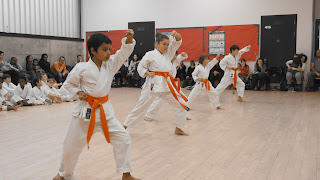Heian Shodan Kata

STUDENT GUIDE TO KATA HEIAN SHODAN The Kata has 21 moves. Heian Shodan originally the second of the five kata, this is now practiced as the first by most novice students in modern Shotokan Karate clubs. Heian Shodan is distinguished by its use of the down block, the upper block, the middle level stepping punch, the sword hand block, and the fact that every technique takes one step to complete. The purpose of this kata is to teach the student basic stepping in a front stance and back stance, to teach the application of stepping punches following blocks which remove any obstructing limbs, and the use of blocking as attacking. Heian Shodan is generally best introduced to students after they have completed a 2 month long sequence of training in the basic techniques. They should be familiar with the concepts of the individual hand and foot motions, the three basic stances, the basic kicking techniques, and the processes involved in advancing, retreating, and turning t
